| |
 |
 |
 |
 |
-GURU
|
 |
This is part three of of our series on locks and keys.
- Lock Basics
- Wards and Bits
- Lever Tumblers
- Padlocks
Our recent Masterpiece Lock coverage in Volume 26 of the anvilfire NEWS
suggested this series on locks and keys.
Locks are relatively simple mechanical devices if you understand how they work.
Many years ago I took a course in Locksmithing that covered a great deal more than simple bolt locks in order to learn some of this.
As a result I am a Certified Locksmith albiet non-practicing.
Since starting this series I have purchased numerous books on locks and locksmithing.
I have been looking mostly for details on old lock designs and have found a few.
One book on Iranian locks was full of very "smithie" padlocksm thus the addition to this series.
I also hope to add more details of medieval locks.
|
 |
 |
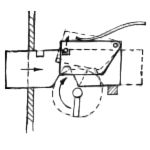
Figure 1
Click for Detail |
In part one we discussed simple bit key operated locks. Most of these locks have a lever or a spring "tumbler".
A tumbler is a part of the lock that prevents the movement of the bolt (locking bar). In simple lever tumbler locks the tumbler is lifted by the key and the bolt can be moved by further rotation of the key. Lifting the tumbler to any height above the bolt lets the bolt move. This provides little security but makes the lock smooth and positive in its operation.
|
 |
-GURU
|
 |
The tumbler shown above has a light spring to hold it in place. In a large heavy lock such as my gate lock shown at the top gravity is sufficient to hold the tumbler in place.
|
 |
 |
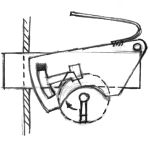
Figure 2
Click for Detail |
In 1778 by Robert Barron of England invented the basic lever tumbler. In his lock the bolt had a slot cut in it to which the tumbler had to be lifted in alignment (not too high or too low) in order to move the bolt. Later the slots were put in the lighter material of the tumbler (as shown) which made the locks much easier to manufacture.
Here the lock is shown with the bolt "shot" in the locked position, the tumbler preventing its movement.
|
 |
 |
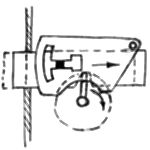
Figure 3
Click for Detail |
Here the tumbler has been lifted so that the dog on the bolt can slide in the slot of the tumbler. The bolt is shown half shot.
Good locks have square corners on the dog and in the tumbler slots so that they must be acurately aligned for the bolt to be shot. Round corners and loose fits make the lock easy to pick.
|
 |
 |
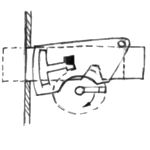
Figure 4
Click for Detail |
Now the bolt has been fully retracted and the tumbler is holding the bolt in place. To shoot the bolt into the locked position the key must ligt the tumbler in the same manner as for unlocking.
Lever tumbler locks have been made in production with as many as six tumblers that each of which had to be raised to the exact height to operate the lock. These locks were used on lock boxes, treasure chests and vaults.
|
 |
-GURU
|
 |
A later development in locks by Chubb made these locks almost unpickable. Chubb added a device called a "detector" that was triggered by raising any of the tumblers too high. The detector then engaged a special tumbler that prevented the bolt from being shot.
In order to open the lock once the detector had been tripped the proper key had to be rotated in the locking direction to reset the detector. then the key could open the lock.
The detector did two things. It made the lock nearly impossible to pick AND it notified the keyholder that the loack had been tampered with.
Although the best of key operated locks have been found to be pickable, it often took months of study and the making of special tools and repeated practice to pick these high security lever tumbler locks.
|
 |
 |
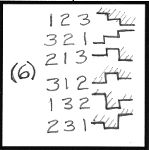
Figure 5 |
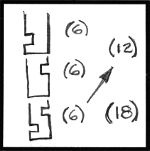
Figure 6 |
 |
 |
-GURU
|
 |
For the maker of hand made locks a simple three or four tumbler lock can be relatively secure and give many key combinations.
In figure 5 I have used three tumblers with three key heights and not duplicated any of the tumblers. This results in six key variations using cobinations of three parts. If combined with different key sections as in figure 6 then twelve locks can be made using similar parts. A third "master" key section is shown that will in turn operate six locks that the previous two do not PLUS one of each of the master set will open two of the other locks.
Increasing the number of tumblers OR the steps greatly increases the number of lock combinations. The increment between steps is determined by the precision of the lock and parts in proportion to the size of the lock. But is is easy to produce hundreds of combinations using four tumblers and four heights all in the same shape key.
This is important to think about and understand if you are asked to make locks for a large home or a hotel OR if you setup to make one one similar lock to sell to numerous clients.
|
 |
 |
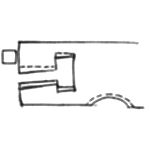
Figure 7
Click for Detail |
One interesting design I found for a lever tumbler had the slot open to the end of the tumbler. As you can see this simplifies the part and makes it easier to manufacture by hand using saws and files.
|
 |
 |
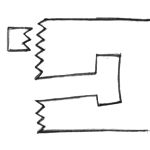
Figure 8
Click for Detail |
Here is the same tumbler design with a saw tooth edge. When the lock picker applies tension to the bolt the teeth engage making it very difficult to move the tumbler and feel the correct alighment. Backing out of the teeth would likely release tumblers held in place by tension. . .
Traps in the tumbler slot have also been used but it is very difficult to design a lock with traps that can be easily reset like the Chubb detector lock. So if you design tricky things into your lock be sure you do not create a lock that can jambed up and not unlocked with the correct key.
|
 |
-GURU
|
 |
Questions, Comments?
|
 |
Ntech
|
 |
Good material. Thanks
|
 |
|
 |
Links
|
 |